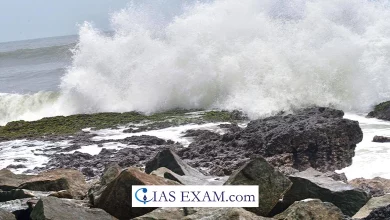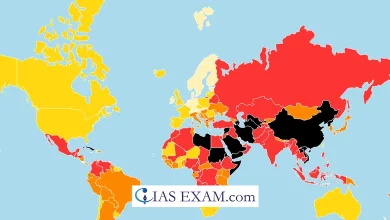Daily Current Affairs for UPSC
Awareness of Degrees of Terrorist Financing
Syllabus- International Relations [GS Paper-2]

Context
At the recent plenary, delegates from the Financial Action Task Force participated in the discussions on key money laundering, terrorism financing and proliferation financing issues at the FATF headquarters in Paris.
Key Highlights
- The second Plenary of the FATF under the Presidency of T. Raja Kumar of Singapore concluded recently.
- Delegates from over two hundred jurisdictions of the Global Network participated in those discussions at the FATF headquarters in Paris.
- One of the important highlights of the FATF Plenary is that it has suspended the membership of the Russian Federation.
- In a prime milestone, the FATF agreed on revisions of transparency and beneficial possession of legal provisions.
- Delegates also agreed on a new level in order to assist countries and the personal zone enforce FATF’s reinforced necessities on transparency and beneficial ownership of legal persons.
- Delegates similarly agreed on a motion plan to power timely global implementation of FATF requirements referring to virtual assets (additionally termed crypto assets) globally.
FATF
-
- The Financial Action Task Force (FATF) is an intergovernmental business enterprise based in 1989.
- It is an initiative of the G7 nations to expand rules to fight money laundering.
- In 2001, its mandate was expanded to encompass terrorism financing.
- It has also begun managing digital currencies.
- It unites international standards that aim to prevent these illegal activities and the harm they cause to society.
- It is a “policy-making frame” which matches to generate the political will to result in country wide legislative and regulatory reforms in cash laundering.
- It monitors development in implementing its pointers via “peer evaluations” (“mutual reviews”) of member nations.
- The FATF Secretariat is located in Paris.
- Objectives of FATF
-
-
- FATF sets standards and promotes powerful implementation of:
- legal, regulatory and operational measures for preventing money laundering.
- The FATF works to perceive national-level vulnerabilities with the purpose of protecting the international financial system from misuse.
- FATF sets standards and promotes powerful implementation of:
-
- Members of FATF:
-
- The FATF currently comprises 38 member countries and two nearby corporations, representing most important financial centres in all parts of the world.
- India became an Observer at FATF in 2006. In 2010, India was taken in as the 34th member country of FATF.
What are FATF ‘Grey List’ and ‘Black List’?
-
- FATF has 2 types of lists:
- Black List:
-
-
-
- Countries known as Non-Cooperative Countries or Territories (NCCTs) are positioned in the blacklist.
- These nations support terror investment and money laundering activities.
- The FATF revises the blacklist often, including or deleting entries.
-
-
-
-
-
- Countries which can be considered a secure haven for helping terror funding and money laundering are placed in the FATF gray listing.
- This inclusion serves as a a warning to the country that it may enter the blacklist.
-
-
- Consequences of being in FATF Grey List:
-
-
- Economic sanctions from IMF, World Bank, ADB
- Problem in getting loans from IMF, World Bank, ADB and different nations
- Reduction in international trade
- International boycott
-
Significance of the FATF
- The FATF Recommendations offer a comprehensive framework of measures to help countries tackle illicit financial flows.
- These include a strong framework of legal guidelines, guidelines and operational measures to ensure the national government can take effective measures to come across and disrupt economic flows that fuel crime and terrorism, and punish the ones chargeable for illegal activity.
- The cornerstone of the FATF Recommendations is the chance-based technique which emphasizes the need for international locations to identify and recognize the cash laundering and terrorist financing risks they’re uncovered to.
- This guarantees they can prioritise their resources to mitigate risks within the highest chance regions.
- The FATF constantly video displays new and evolving threats to the monetary machine and regularly updates and refines its Recommendations so that nations have up-to-date tools to go after criminals.
- To assist nations put into effect its Standards, the FATF also creates guidance and high-quality practice papers on a variety of problems.
FATF and India’s Legal and Institutional Frameworks
- Money laundering has evolved as a huge concern in India thinking about the reality that the country is one among the largest growing economies in the world.
- Illegal activities devoted inside and outside the country, like drug trafficking; fraud, counterfeiting of Indian forex; transnational organised crime; human trafficking; and corruption are the sources of money laundering in India.
- As far as the legislative framework in the country is concerned, the first parliamentary law supplied for the prevention of positive unlawful activities of people and institutions and for subjects linked therewith.
- It was called the Unlawful Activities (Prevention) Act, 1967 (UAPA) which was amended in 2004 to criminalise terrorist financing.
- The Conservation of Foreign Exchange and Prevention of Smuggling Activities Act, 1974 was brought to prevent smuggling.
- The Smugglers and Foreign Exchange Manipulators Act, 1976 furnished for the forfeiture of illegally obtained houses of smugglers and forex manipulators.
- The Foreign Contribution (Regulation) Act, 1976 regulated the recognition and usage of foreign contribution and foreign hospitality via humans and institutions operating in important areas of national life.
- The Narcotic Drugs and Psychotropic Substances Act, 1985 made stringent provisions for the control and rules of operations regarding narcotic pills and psychotropic substances.
- The Foreign Exchange Management Act (FEMA), 1999 became enforced to modify the improvement and upkeep of the forex market.
- The Prevention of Money Laundering Act, 2002 (PMLA) which came into force in 2005 and amended in 2009 and 2012 was brought to counter money laundering.
Source: The Hindu
UPSC Mains Practice Question
Q.Discuss how emerging technologies and globalisation contribute to money laundering. Elaborate measures to tackle the problem of money laundering both at national and international levels. (2021)





.png)



